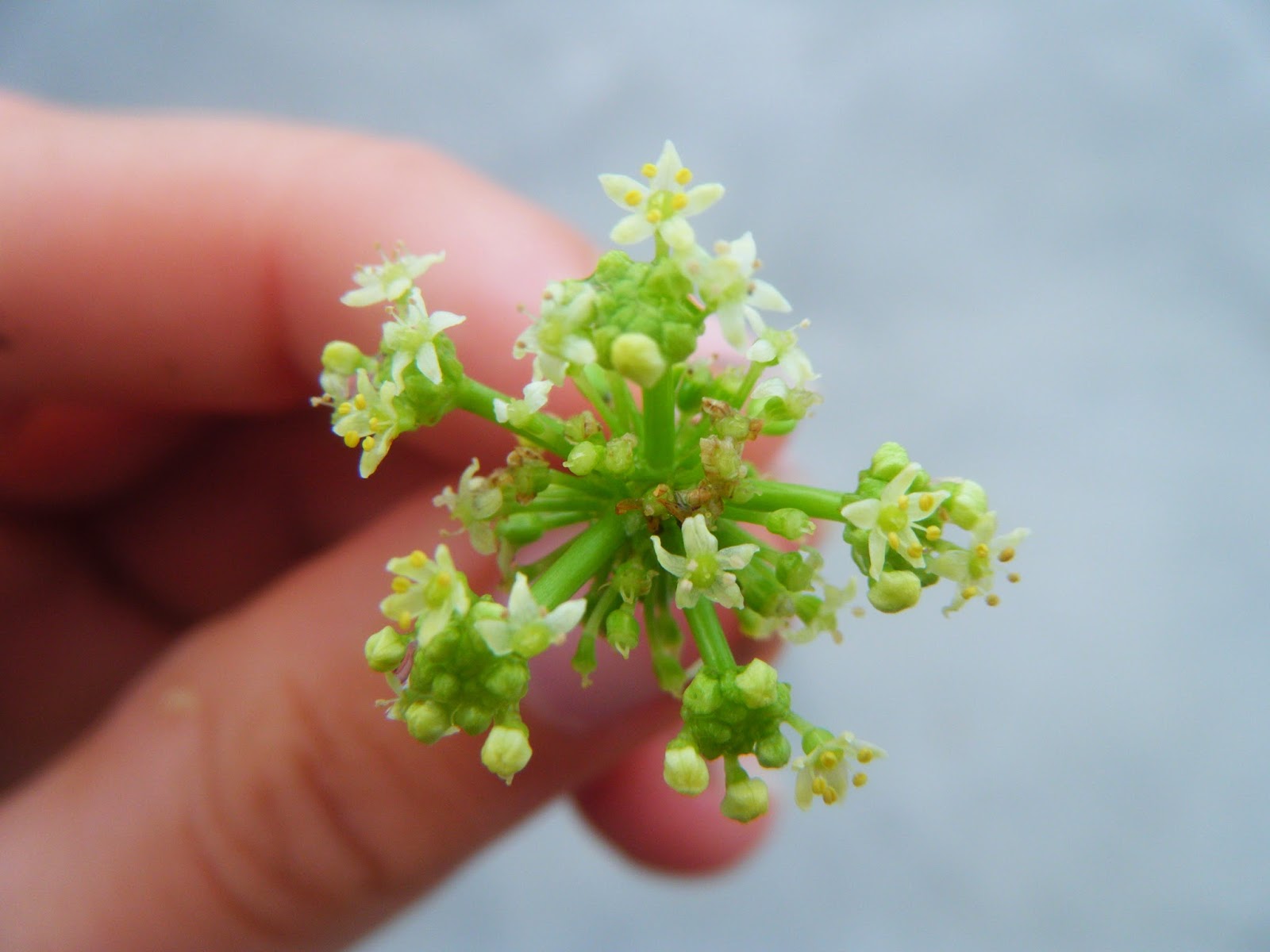Now for that showcase of Pennywort aka
Dollar Weed ...
 |
| Large-leaf Dollar Weed (Hydrocotyle bonariensis) |
Let's begin with the basic identifying features of Pennywort (Hydrocotyle spp.) and then we'll get into what species can be found here on the MST and how to differentiate between them.
Pennywort is a long-stemmed plant bearing only basal leaves. These basal leaves are shiny green and round with scalloped margins. Leaf stem attaches directly to the center of the leaf. Mature leaves are roughly the size of a half dollar- thus the origin of one of it's common names. To call it Pennywort is really to undermine it's size, although this is what I most often hear it called.
 |
| Pennywort stems attach directly to center of leaf |
It's flowers are characteristic of it's
family, the Carrot family (Apiaceae). Flowers are tiny, containing
five yellow-tipped stamens, surrounded by five white pointed petals,
and cupped by five green sepals. These star shaped flowers grow in
umbels, also characteristic of its family.
 |
| Five-petaled flowers of Pennywort |
 |
| Pennywort standing tall in a Marsh |
If traveling from the sea, the first species you will encounter is Large-leaf Dollar Weed (H.bonariensis). This is the Pennywort of the dunes and beaches. I have found it growing almost as abundantly as the grasses with which it often shares a home.
However don't let it's name fool you. I have not found this species' leaves to be consistently larger. In fact, often times they will be smaller than the species I will explain next. Different plants will produce different sized leaves.
 |
| A truly large Large-leaf Dollarweed |
 |
| A smaller Large-leaf Dollarweed |
What does distinguish this Pennywort is it's compound umbel. Firstly, let's define an umbel: an umbel is term used to describe an arrangement of flowers. From one flowering stalk grows a spray of skinny stems that branch out like the arms of an umbrella. A compound umbel is when atop each of these skinny stems is an even smaller spray of skinnier stems. Flowers will also grow in a tight whorl around the branches of an umbel.
 |
| Compound umbel of Large-Leaf Dollar Weed |
The second species you will encounter
is Marsh Dollar Weed (H.umbellata). This is the Pennywort of not only
marshes, but wet lawns and run-off areas. So it depends, if you're
spending most of your time walking the roads, you may meet this lil
face first. You will definitely spot this Pennywort in the Croatan
forest and roadwalks through the marshlands.
What sets Marsh Dollar Weed apart from
Large-leaf Dollar Weed is it's simple umbel of flowers. Each
flowering stalk will bear just one umbrella-like spray of flowers.
So now that we know how to identify Pennywort and the two species that can be found on the MST, let's get to the good stuff...
This is your Coastal Plain edible green!
Slice it, dice it, or throw 'em in a stew...they are deelish raw or cooked. I like to use the smaller leaves sliced finely in salads or wraps and save the larger leaves for boiling with a pot of noodles or tossing in a stir-fry and cooking well. BE SURE TO READ CAUTION BELOW on harvesting from polluted areas.
(Recipe from: A Guide to the Edible
and Medincinal Plants of the Mountains to Sea Trail)
Fruit Salad with Pennywort
1 cup of diced pineapple (fresh or canned)
1 mango, diced
1 small handful of blueberries
1 small handful of Pennywort, finely
slivered/shredded
a dash of granulated or powdered sugar
(optional)
Grasping Pennywort leaves in a tight bunch, finely sliver with a sharp knife as you would a bunch of herbs. Combine fruit and Pennywort leaves in a bowl. Toss to combine and sprinkle lightly with a little sugar for added sweetness.
CAUTION:
Being that Pennywor is a water-loving plant, it can easily become a highly toxic plant if living in a polluted environment. It is also considered a loathsome weed. Therefore, do not harvest Pennywort from unknown lawns where weed killers may have been applied, from runoff areas along the edges of roads or parking lots, or from polluted swamps or marshes. So sad, considering you WILL find Pennywort growing abundantly in all of these areas...luckily you can easily find it on healthy turf as well!
Awesome! Thanks for sharing and happy trails!
ReplyDeletethanks for the info on how to differentiate. Any tips for like herbal tea or any beverages?
ReplyDeleteUnfortunately, I do not have any experience with using it as a tea, nor have I come across any use of it this way. It seems it is more an herb to use for seasoning. However, keep researching, many herbs have lesser known uses that are credible.
DeleteHi, Heather, I found your blog by searching knowledge about Hydrocotyle umbellata. I´m wisiting in NC from Finland and I´m interested using wild plants for food.
ReplyDeleteYou think it´s safe to eat this pennywort? In some articles they say that it can cause nause... Is it because of toxics it can absorb e.g. from thr lawn?
Liina
Good day. I was wondering on what is the difference between H. umbellata and H. vulgaris. I am trying to identify my subject for my thesis. Thank you!
ReplyDelete